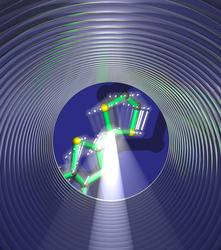“Magic” of Chemistry Revealed
Scientists of the Atomically Resolved Dynamics Division capture image of atoms moving in real time
Call it the ultimate nature documentary. At an incredibly fast frame rate of less than 1 millionth of a millionth of second, scientists from the Atomically Resolved Dynamics Division of the Max Planck Research Group for Structural Dynamics, University of Hamburg within the Center for Free-Electron Laser Science (CFEL), University of Toronto, Tokyo Technology University and Kyoto University were able to record atomic motions in real time, offering a glimpse into the very essence of chemistry and biology at the atomic level. Playing back these motions at video rate for our viewing pleasure represents the ultimate in super slow motion recording.
Described in a study reported this week in Nature, it provides a direct observation of a so-called transition stat in which atoms undergo chemical transformation to new structures and properties, in this case the transfer of charge leading to metallic behaviour in organic molecules.
“It’s the first look at how chemistry and biology involve just a few key motions for even the most complex systems. It is this enormous reduction in complexity at the defining point, the transition state region or “point of no return” that makes chemical processes transferrable from one type of molecule to another. A chemist can take a chemical concept and use it on a wide variety of different molecules to exactly position atoms where we want. We use this to make new drugs or materials. More miraculous, Nature uses this reduction principle at transition states to breathe life into otherwise inanimate matter. Imagine the complexity of all the enormous number of possible arrangements of atoms in DNA or any other biologically active molecule. It borders on astronomical dimensions yet it always does the same thing to drive a biological function. We now see for the first time how all these possible motions become coerced along a particular pathway by a dominant player,” says Professor R. J. Dwayne Miller, Principle Investigator of the study.
Miller and colleagues found that no matter how complex molecules are that the interconversion in structure reduces to a few key motions. He describes the process by saying with two atoms there is only one possible coordinate or dimension for following the chemical pathway. With three atoms, two dimensions are now needed. However, with a complex molecule, it would be expected that hundreds or even thousands of dimensions would be required to map all possible trajectories of the atoms.
“In this case, chemistry would be a completely new problem for every molecule,” says Miller. “But somehow it undergoes this enormous reduction in dimensions to just a few motions. This is the magic of Chemistry and we are now able to see exactly how this works at the atomic level of detail. We were able to map all the possible atomic motions on to just three key modes, and found it is the slowest motion between what is called inertial and Brownian motion (rapid collisions) that directs atomic traffic from one structure to another. It is like watching a traffic jam going up a mountain pass and suddenly the mountain collapses with a new lane appearing for the atoms to follow.”
The results build on a milestone first reached by Miller and former graduate students a decade ago. “One of the long standing dream experiments in science is to directly observe atomic motions during the defining moments that lead to structure change,” says Miller. “We were able to watch simple phase transitions at the atomic level back in 2003, that ultimately led to a new understanding now used for laser surgery that has achieved the long held promise of the laser for minimally invasive surgery. This is a great testimony to the importance of basic science. One never knows where new understandings will lead. This was the first so called molecular movie where we had enough diffraction or information to invert to atomic motions on the 100 femtosecond time scale, relevant to catching atoms on the fly. These first atomic movies were very grainy much like the first motion pictures. The new movies are so clear one could dare say they are becoming beautiful to behold, especially when you think you are looking at atomic motions. One can only guess where these new insights will lead.
The breakthrough was based on the development of ultrabright electrons sources that dates back to their work in 2003. The only other way to catch atomic motions is with x-rays, similar to those in your doctor’s office that to right through you. In contrast electrons interact with atoms 1 million times stronger and can be produced with a table top instrument to produce enormous effective brightness for viewing atomic motions.“No one thought we could ever develop a bright enough source based on electrons as they undergo electron-electron repulsion and would blow up without being able to capture an image on the incredibly short time scale required,” says Miller. “We found a way to coerce the electrons into an ultra-short pulse sufficiently bright to literally light up atomic motions as they occur.”
Funding for this research was provided by the Max Planck Society, Natural Sciences and Engineering Research Council of Canada, and the Canada Foundation for Innovation. Additional support was provided by a Grant-in-Aid for Scientific Research on Innovative Areas and the G-COE program for the field of Chemistry from The Ministry of Education, Culture, Sports, Science and Technology in Japan, and by Creative Scientific Research from The Japan Society for the Promotion of Science.
Full credits at the end of the movie.

